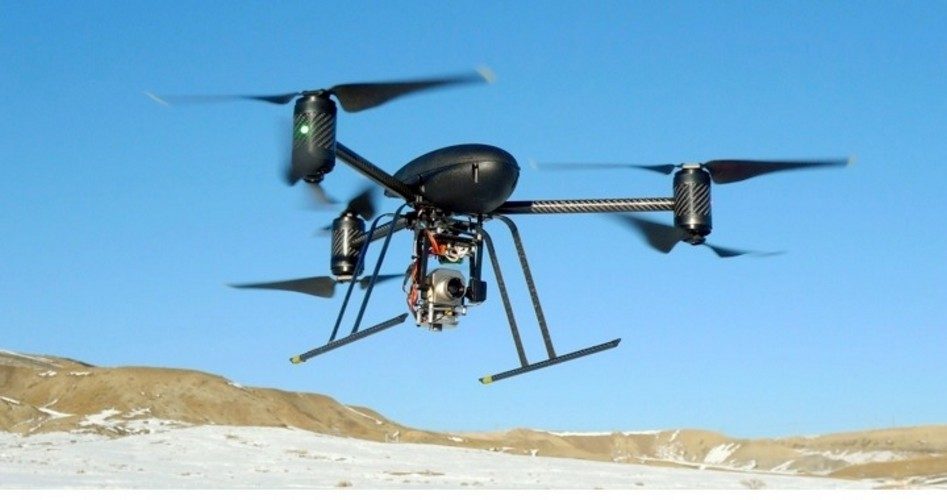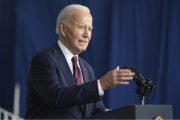
The day of deployment is drawing nearer. Soon, thousands of Federal Aviation Administration (FAA) unmanned aerial vehicle license holders will launch their drones into the skies over the United States.
Despite the delay of lawmakers to establish constitutionally sound guidelines for the use of these eyes in the sky, a handful of congressmen are pushing to move forward the date of deployment.
Why would legislators — typically not the most hurry-happy group — be interested in accelerating the drive to permit civilian drone use?
Money.
A collaboration between Hearst Newspapers and the Center for Responsive Politics paints the pecuniary picture:
The drone makers have sought congressional help to speed their entry into a domestic market valued in the billions. The 60-member House of Representatives’ “drone caucus” — officially, the House Unmanned Systems Caucus — has helped push that agenda. And over the last four years, caucus members have drawn nearly $8 million in drone-related campaign contributions….
And:
House members from California, Texas, Virginia and New York on the bipartisan “drone caucus” received the lion’s share of the funds channeled to lawmakers from dozens of firms that are members of the Association for Unmanned Vehicle Systems International, Hearst and CRP found.
Eleven drone caucus lawmakers from California, where many aviation firms are located, received more than $2.4 million from manufacturers’ political action committees and employees during the 2012 and 2010 election cycles, according to CRP tabulation of Federal Election Commission reports.
Eight Texas House members in the caucus received more than $746,000. And four caucus members from New York got more than $185,000 from companies connected to the business of unmanned vehicles.
The big winner of the drone manufacturer lobbying lotto was Representative Howard “Buck” McKeon (R-Calif.). According to the investigation, McKeon — cochairman of the House Unmanned Systems Caucus — received $833,650 in contributions from the drone industry.
Members of California’s House delegation also received significant deposits from drone makers and advocates. Representatives Darrell Issa, Jerry Lewis, Duncan Hunter, and Ken Calvert each received more than $200,000 from this segment of the military industrial complex.
According to the Hearst/CRP investigation, drone makers knew better than to mess with Texas and a few of the Lone Star State’s representatives saw their coffers swell with drone dollars:
Silvestre Reyes, D-El Paso, a former U.S. Border Patrol sector chief who lost his seat in the Democratic primary, received $310,000.
Rep. Michael McCaul, R-Austin, chairman of the House Homeland Security subcommittee on oversight, received $100,000, and Cuellar received almost $77,000. The two have pushed for drone surveillance of the U.S.-Mexico border.
Given the amount of money flowing between the drone makers and the lawmakers, it is odd that most Americans have never heard of the Unmanned Systems Caucus.
The relationship between drone makers and lawmakers was recently reported by an Arizona radio station:
The drone caucus — like the technology it promotes — is becoming increasingly important in the nation’s capitol as the government looks to unmanned vehicles to help save money on defense, better patrol the country’s borders and provide a new tool to U.S. law enforcement agencies and civilians.
“It’s definitely a powerful caucus,” said Alex Bronstein-Moffly, an analyst with First Street Research Group, a D.C.-based company that analyzes lobbying data.
“It’s probably up there in the more powerful caucuses that sort of is not talked about.” And, he says, caucus members are well placed to influence government spending and regulations.
The influence peddling isn’t restricted to the representatives listed above. According to Bronstein-Moffly’s data, all 58 drone caucus members received money, more than $2.3 million in total contributions from political action committees affiliated with drone manufacturers since 2011.
General Atomics, maker of the Predator drone, is among the top three all-time campaign contributors to Congressmen Calvert, Lewis, and McKeon.
In 2010 and 2012, General Atomics’ PAC has paid out over $140,000 in donations to drone caucus members representing states located on the border with Mexico.
A PAC largely financed by Northrop Grumman contributed about $150,000 to 16 congressmen in the drone caucus who represent districts in California, Texas, Arizona, and Nevada.
No wonder these companies are champing at the bit to grease the skids for the removal of obstacles to their overseas sales plans. In a recently published study, the Teal Group estimates that UAV spending will almost double over the next decade from current worldwide UAV expenditures of $6.6 billion annually to $11.4 billion, totaling just over $89 billion in the next 10 years.
“The UAV market will continue to be strong despite cuts in defense spending,” said Philip Finnegan, Teal Group’s director of corporate analysis and an author of the study. “UAVs have proved their value in Iraq, Afghanistan and Pakistan and will continue to be a high priority for militaries in the United States and worldwide.”
Thankfully, there are some in Congress who recognize the threat to liberty posed by 30,000 domestically deployed drones.
The San Francisco Chronicle reports, “The drones are coming,” shouted Rep. Ted Poe (R-Texas) earlier this year from the House floor, as he warned of encroachment by government into the rights of citizens.”
Representative Poe is not alone. In June Senator Rand Paul (R-Ky.) introduced a bill to “protect individual privacy against unwarranted governmental intrusion through the use of unmanned aerial vehicles commonly called drones.” Paul’s bill mandates: “A person or entity acting under the authority [of], or funded in whole or in part by, the Government of the United States shall not use a drone to gather evidence or other information pertaining to criminal conduct or conduct in violation of a statute or regulation except to the extent authorized in a warrant that satisfies the requirements of the Fourth Amendment to the Constitution of the United States.”
Senator Paul explained, “Americans going about their everyday lives should not be treated like criminals or terrorists and have their rights infringed upon by military tactics.”
Constitutional conflicts arising in the wake of the domestic deployment of drones have already come up in court in the case of North Dakota farmer Rodney Brossart, who became one of the first American citizens (if not the first) arrested by local law enforcement with the use of a drone owned by a federal agency. Police launched this loaner after Brossart held the police at bay for over 16 hours.
A standoff ensued, and the Grand Forks police SWAT team made a call to Grand Forks Air Force Base, home to one of the Department of Homeland Security’s squadron of Predator drones. No sooner did the call come in than the drone was airborne, and Brossart’s precise location was pinpointed with laser-guided accuracy. The machine-gun toting SWAT officers rushed in, tased, and then arrested Brossart on various charges, including terrorizing a sheriff.
At a hearing held in North Dakota on August 1, Judge Joel Medd upheld Brossart’s arrest.
Senator Paul’s measure, if enacted, would give specific guidance to the judicial branch’s understanding of the Fourth Amendment and the scope of its prohibitions. It would prevent citizens from being subject to surveillance without notice.
In practice, this would help judges apply the principles of the Fourth Amendment to drones in a very specific way. The standards presently used to judge the constitutionality of observation by helicopter or patrol car, for example, would be altered appropriately to fit the rapidly advancing drone technology. The improved legal framework would help law enforcement avoid legally suspect surveillance and would maintain the public’s protection against unconstitutional searches and seizures.
The threat to constitutionally protected liberties is every day more imminent as the day of domestic drone deployment draws nearer. And as reported by the San Francisco Chronicle, the Houston Chronicle, and the CRP, if the members of Congress whose wallets are made fatter by drone industry dollars have their way, that day is closer than we think.
Joe A. Wolverton, II, J.D. is a correspondent for The New American and travels frequently nationwide speaking on topics of nullification, the NDAA, and the surveillance state. He can be reached at [email protected].
Photo of a small Draganflyer X6 drone with a Forward Looking Infared payload: AP Images



